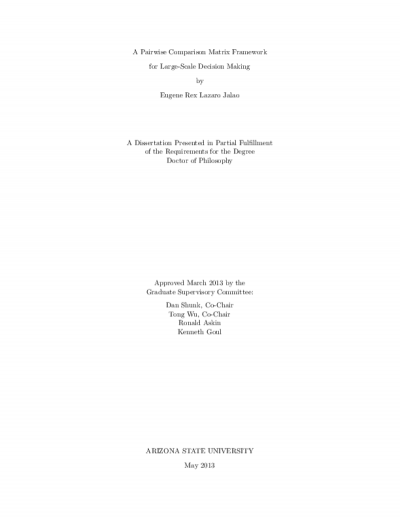A Bayesian network approach to early reliability assessment of complex systems

Description
Bayesian networks are powerful tools in system reliability assessment due to their flexibility in modeling the reliability structure of complex systems. This dissertation develops Bayesian network models for system reliability analysis through the use of Bayesian inference techniques.
Bayesian networks generalize fault trees by allowing components and subsystems to be related by conditional probabilities instead of deterministic relationships; thus, they provide analytical advantages to the situation when the failure structure is not well understood, especially during the product design stage. In order to tackle this problem, one needs to utilize auxiliary information such as the reliability information from similar products and domain expertise. For this purpose, a Bayesian network approach is proposed to incorporate data from functional analysis and parent products. The functions with low reliability and their impact on other functions in the network are identified, so that design changes can be suggested for system reliability improvement.
A complex system does not necessarily have all components being monitored at the same time, causing another challenge in the reliability assessment problem. Sometimes there are a limited number of sensors deployed in the system to monitor the states of some components or subsystems, but not all of them. Data simultaneously collected from multiple sensors on the same system are analyzed using a Bayesian network approach, and the conditional probabilities of the network are estimated by combining failure information and expert opinions at both system and component levels. Several data scenarios with discrete, continuous and hybrid data (both discrete and continuous data) are analyzed. Posterior distributions of the reliability parameters of the system and components are assessed using simultaneous data.
Finally, a Bayesian framework is proposed to incorporate different sources of prior information and reconcile these different sources, including expert opinions and component information, in order to form a prior distribution for the system. Incorporating expert opinion in the form of pseudo-observations substantially simplifies statistical modeling, as opposed to the pooling techniques and supra Bayesian methods used for combining prior distributions in the literature.
The methods proposed are demonstrated with several case studies.
Bayesian networks generalize fault trees by allowing components and subsystems to be related by conditional probabilities instead of deterministic relationships; thus, they provide analytical advantages to the situation when the failure structure is not well understood, especially during the product design stage. In order to tackle this problem, one needs to utilize auxiliary information such as the reliability information from similar products and domain expertise. For this purpose, a Bayesian network approach is proposed to incorporate data from functional analysis and parent products. The functions with low reliability and their impact on other functions in the network are identified, so that design changes can be suggested for system reliability improvement.
A complex system does not necessarily have all components being monitored at the same time, causing another challenge in the reliability assessment problem. Sometimes there are a limited number of sensors deployed in the system to monitor the states of some components or subsystems, but not all of them. Data simultaneously collected from multiple sensors on the same system are analyzed using a Bayesian network approach, and the conditional probabilities of the network are estimated by combining failure information and expert opinions at both system and component levels. Several data scenarios with discrete, continuous and hybrid data (both discrete and continuous data) are analyzed. Posterior distributions of the reliability parameters of the system and components are assessed using simultaneous data.
Finally, a Bayesian framework is proposed to incorporate different sources of prior information and reconcile these different sources, including expert opinions and component information, in order to form a prior distribution for the system. Incorporating expert opinion in the form of pseudo-observations substantially simplifies statistical modeling, as opposed to the pooling techniques and supra Bayesian methods used for combining prior distributions in the literature.
The methods proposed are demonstrated with several case studies.
Date Created
The date the item was original created (prior to any relationship with the ASU Digital Repositories.)
2016
Agent
- Author (aut): Yontay, Petek
- Thesis advisor (ths): Pan, Rong
- Committee member: Montgomery, Douglas C.
- Committee member: Shunk, Dan L.
- Committee member: Du, Xiaoping
- Publisher (pbl): Arizona State University



